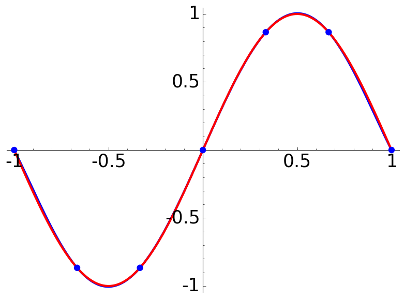|
#######################
#### RUNGE
#######################
def rung(N):
#f = sin(5*pi*x)
#f = sin(pi*x)
#f = 1/(8*x^2+1)
h = 2/(N-1)
xs = srange(-1,1+h/2,h)
ys = [ f(x=xx).n() for xx in xs]
p_i = prod(x-ii for ii in xs);
pid = diff(p_i,x);
g = sum(p_i/(x-ii)/pid(x=ii)*jj for (ii,jj) in zip(xs,ys))
P = plot(g,x,-1, 1, thickness=3)
P += plot(f,x,-1, 1, color='red', thickness=3)
P += list_plot(zip(xs,ys), size=80, zorder=200)
#P.set_aspect_ratio(1)
#P.axes(False)
P.fontsize(25)
return P
P = rung(20)
P.show()
|

